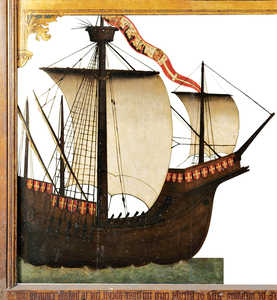Fifteenth century
With increased loading capacity resulting from adoption of
the stern rudder, it also became necessary to enhance propulsion.
Given that the height and area of the ship's single existing
sail could not safely be increased without affecting the overall
stability of the ship, another two masts were added, the
foremast (at the bow) and the mizzen (astern); this new arrangement
considerably improved the way the ship handled,
and the pressure on the helm could be relieved through judicious
adjustment of the sails.
During the second half of the fifteenth century, the new carvel
system of planking began to be widely used in hull building.
This led to a dramatic change in the way ships were
de-signed and built.
Initially it was only used on the submerged part of the hull,
but gradually this planking method came to entirely replace
clinker.
During this phase, too, the round stern was abandoned in
favour of a flat or transom stern, which was far easier to
build.

Ex-voto at the Church of St. Peter (San Pedro) in Zumaia, depicting
the victory of the ships of Juan Martínez de Mendaro over the
Portuguese and Genovese navies in the Straits of Gibraltar in
1475. © José Lopez

The altarpiece dedicated to Santa Ursula at the church of
Cubells, painted by Joan Reixach in 1468, and the model of the
Mataró cog shows that one-masted vessels were still being used in
this part of the Mediterranean around the middle of the fifteenth
century. However, they both contain construction features that are
similar to the Zumaia. The image on the altarpiece shows in some
detail the morphology of the stern, which cannot be clearly seen
in the picture from Zumaia. The bow of the Mataró cog is very
similar to that of the Zumaia. © José Lopez

Cog from Mataró dated around the mid-fifteenth century. This
is an ex-voto and is the oldest European model ship still extant. It
is in the permanent collection of the Prins Hendrik Maritime
Museum in Rotterdam. This illustration from 1471 shows a modest foremast, but no
mizzen masts can yet be seen aft. These masts gradually developed
until they came to be an essential part of the ship's rig. The adoption
of foresails and mizzen sails made it possible to increase the
sail area without raising the centre of wind pressure, and without
affecting the stability of the ship. © José Lopez

Image taken from the ex-voto showing the Zumaia, flagship of
Martínez de Mendaro's fleet. Note how the foremast and two mizzen
masts are carefully shown. These two sails were now fully
functional after a process of evolution lasting throughout the century.
The forecastle is larger now and is fully integrated into the
structure of the hull, as is the quarterdeck or poopdeck at the stern.
The net effect is to make these features sturdier with a view to increasing
the vessel’s battleworthiness. Note the cannon along the
gunwale and spears at the crow’s nest. –Mizzen sails. –Foresail. The ex-voto in Zumaia does not show the typical relief of a clinker-built hull. The Zumaia may have been one of the first carvel-
built ships; however we cannot be sure because even in previous
depictions of clinker-built ships, the relief was not always
shown. However, it was during this period that the first hybrid hulls
began to develop: a carvel-built draft and clinker-built freeboard.
This the case of the wreck found in Cavalaire, France. © José Lopez

The transom stern increased the cargo that could be carried. © José Lopez

At the end of the fifteenth century, a new sail over the mainsail,
in order to optimise the distribution of the sail area. It was here too,
in the crow's nest, that the lookout sat. The Spanish term for both
the topsail and the crow's nest is "gavia", from the Basque word
kabia, meaning nest. –Topsail. © José Lopez

The rigging began to diversify, with fore, mizzen and main
sails. The freeboard became larger in volume due to an increase in
the tonnage or load capacity. © José Lopez











